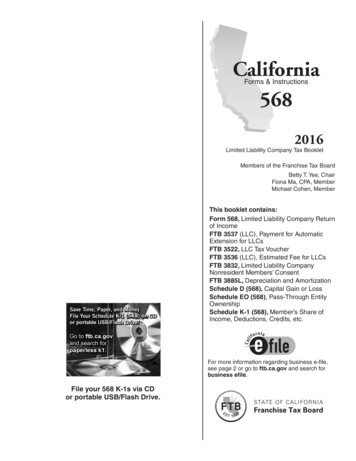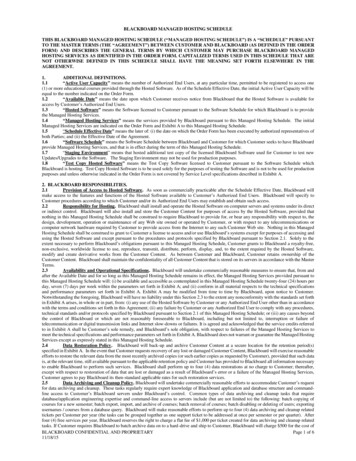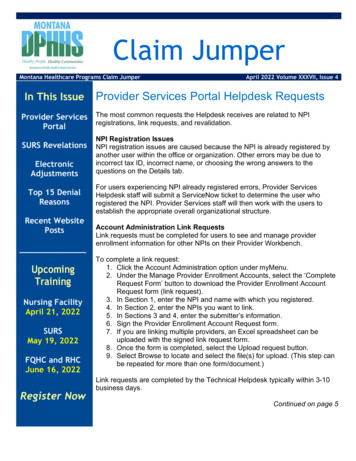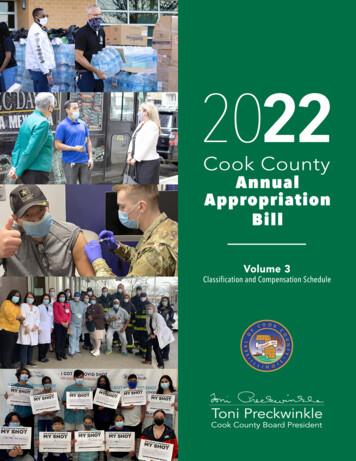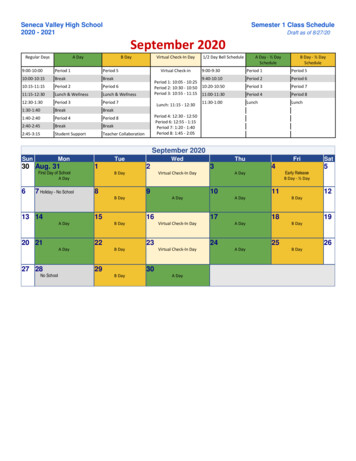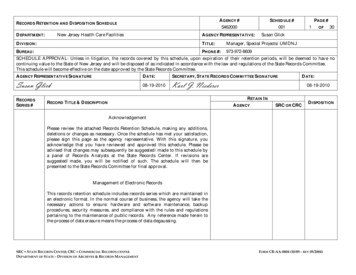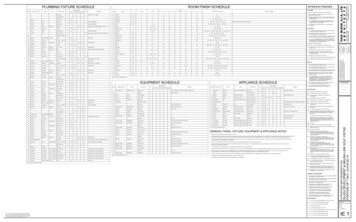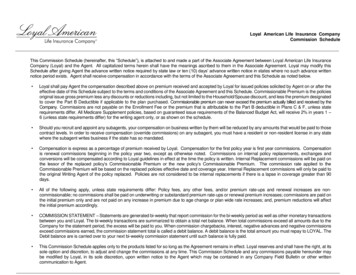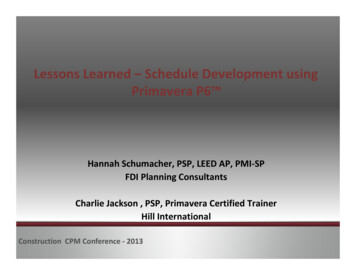
Transcription
Lessons Learned – Schedule Development usingPrimavera P6 Hannah Schumacher, PSP, LEED AP, PMI‐SPFDI Planning ConsultantsCharlie Jackson , PSP, Primavera Certified TrainerHill InternationalConstruction CPM Conference ‐ 2013
Author Biography – Hannah Schumacher Degree: BS – Construction Management and BS – BuildingConstruction Technology University: Wentworth Institute of Technology, Boston, MA Years of Experience: 21 Professional Field: Construction Something you do not know about me: I was born in Italy and livedin France during my childhood
Author Biography – Charlie Jackson Degree: BA ‐ Journalism University: Baylor University, Waco, TX Years of Experience: 17 Professional Field: Construction Something you do not know about me: Enjoy the unusual ‐ Livedabroad in Russia for two years, enjoy skydiving and scuba diving
IntroductionMany specs are requiring the use of the latest Primavera software (P6 )Our presentation focuses on the use of Primavera P6 to accomplish the1st 7 steps for Schedule Planning and Development (from AACE TCM7.2)1. Plan for Schedule Planning and Development2. Identify Activities3. Develop Activity Logic4. Estimate Durations5. Establish Schedule Requirements6. Allocate Resources7. Optimize Schedule
Application Download & InstallationOracle E‐Delivery website: http://edelivery.oracle.comUsing either database engine Oracle or Microsoft SQL, install the clientapplication and connect the client to the database.Note: Do not use the sample database as the production environment.
Application StructuresProject Management or P6 organizes project information based onhierarchical structures. Each structure consists of at least one root orbase level and multiple sub or lower levels.At the highest level the projects are typically organized around an‘Enterprise Project Structure’ or grouping of the database of projects(i.e. type, clients, phasing, etc.). Projects are organized by commonattributes based on the organizational requirements.
Plan for Schedule Planning & Development Planning Considerations – project level or contractualorganizational requirements as well as internal organizationalrequirements Application IntegrationGlobal/Project Structures Project Definition and CodingWork Breakdown Structure and CodingActivity Code Structures (Global/Project)Activity Structures (ID’s and Naming Conventions)Resource / Cost RequirementsDurations and Global/Project CalendarsCalculation RulesOptimization and ReportingMaintain Consistency1. Project Structures2. Global Structures
Plan for Schedule Planning & Development Scheduling System Integration Considerations Export Format and Import Templates – XML/XER exports and ImportConfigurationsPrimaveraP3 PrimaveraP6 MicrosoftProject Integration with Primavera P3 Integration with Microsoft Project Integration with other Primavera P6 PrimaveraP6
Plan for Schedule Planning & Development Organization of Databases within Primavera P6 Production database Intermediary ionRequiredYesDataRevisedNo‘Production’
Plan for Schedule Planning & Development Enterprise Project Structure (EPS) Organizes projects in the database By Division , Location, Client, etc.
Plan for Schedule Planning & Development Adding the Project Enter the Project Basics Project ID to identify thetype of schedule (Current,Baseline, What‐if, TIA) Planned Start Must Finish By (if required)
Identify Activities Start with Structures Work Breakdown Structure (WBS) – Project specific Organizational breakdown of the project (Phase, Area, Location, etc. and/or CostBreakdown) Used for Earned Value
Identify Activities Start with Structures WBS Categories – GLOBAL Code WBS levels (Admin menu, Admin Categories) Group activities across the Enterprise
Identify Activities Start with Structures Activity Codes structure(Enterprise menu, Activity Codes) Global EPS Project Consider existing structures Naming convention toavoid system confusionGlobal Code –‘Global’ Code NameProject Code –‘Project Identifier’ Code Name
Identify Activities Activity ID Smart ID (i.e. CSI division or location identifier) Limit to 10 characters if importing / exporting to P3/SureTrak Auto‐numbering (Project Details, Defaults tab) Can be modified easily in P6, version 7 (Edit menu, Renumber ActivityIDs) Increment Activity ID Auto number Replace BeginningCharacters
Identify Activities Activity Name Clear, concise, and consistent Keyword as left‐most word in name (helpful for Sorting, Searching in Predecessor/Successor windows)Limit to 48 characters if importing / exporting to P3 / SureTrak
Identify Activities Activity Type MilestonesTask Dependent and Resource DependentLevel of Effort and WBS SummaryDefault Activity type is set at Project Level (Project Details, Defaultstab) Change type at Activity Level(Activity Details, General tab)
Develop Schedule Logic Four Precedence Relationship Types FS, FF, SS, SF Lags and Leads Scheduling Option (Tools menu, Schedule, Options) to choose whichcalendar determines lags / leads
Develop Schedule Logic Three Methods for Assigning Relationships Predecessor and Successor Windows(Group and Sort by, Columns) Linking Activities(no ‘Unlink’ option) ‘Drawing’ Relationships
Estimate Durations Calendar Types (Enterprise menu, Calendars) Global (templates) Resource Project (project specific)DETAILEDperiods.TOTAL Work Periods ‐ System calendars are set to 8 hour workImportant – P6 always calculates to the minute
Estimate Durations Preferences (Admin/User) for determining and displaying: TIME UNITS (Edit menu, User Preferences, Time Units tab)Check Dates and Times (Start/Finish) (Edit menu, User Preferences,Dates tab)
Estimate Durations TIME PERIODS (Admin menu, Admin Preferences, Time Periods tab)Version 7 allows workday to be defined at calendar level“Use assigned calendar to specify the number of work hours foreach time period”Note: Issue with BL workdays, uses 8 hours regardless of Calendar. Oracle issue # [ID 906081.1]
Establish Schedule Requirements Contract time requirements regarding start/finish dates. Non‐precedence Constraints (Activity Details, Status Tab) Primary Secondary Types Start on or AfterFinish onFinish on or AfterMandatory StartStart on or BeforeMandatory FinishFinish on or BeforeAs Late as PossibleStart onMust Finish by (Project Constraint)Note: there is no Zero Total Float option (now use Finish onor Before)Note: there is no Zero Free Float option (now use As Late AsPossible)
Allocate Resources Define Resource Breakdown Structure (RBS) and Cost Accounts– GLOBAL Resources can be Labor, Non Labor, and MaterialIdentify Project Resources vs Global Resources (Example:Project ID Name) using hierarchical structure
Allocate Resources Defining Resource Settings (should be initially defined) Resource Details for Labor, Nonlabor, Material Auto Compute Actuals Calculate costs fromunits Activity Details Override Resource Details settings
Allocate Resources And at Project Level (Project Details, Calculations tab) Link Actual and Actual This Period Units and Costs (when usingFinancial Periods) Resources Drive activity dates by default(Project Details, Resources tab)
Allocate ResourcesOther Project level defaults to consider prior to developing activitylist (can be set to specific activities) Duration Types Fixed Duration and Units (default)Fixed Duration and Units/TimeFixed UnitsFixed Units/Time
Allocate Resources Percent Complete Types Duration Percent Complete (default) Physical Percent Complete Units Percent Complete Default type defined at the Project Level (Projects Details, Defaults tab) and can be changed at the Activity Level (ActivityDetails, General Tab)Project Level defaults only apply to new activities.
Allocate Resources Financial Periods – GLOBAL Defined at Admin Level (Admin menu, Financial Periods)
Allocate Resources Resource Distribution and Curves / Future Bucket Planning System Default andGlobal (Enterprisemenu, ResourceCurves) Can add new curves by copying a default curve and modifyingsettings Assign at the Activity Level (Activity Details, Resources tab)
Optimize Schedule Schedule Options General Relationships to and from otherProjects Open ends Schedule Calculation options Retained Logic Progress Override Actual Dates Critical activity definitionCalculate SS lagFloat definitionCalendar for scheduling relationship lag
Optimize Schedule Schedule Options Advanced Calculate multiple float paths by either Total Float or Free Float For more information regarding multiple float paths read ‘Longest Path to the Rescue’ byRon Winter.
Optimize Schedule Schedule Log Claim Digger Tabular Reports
Data Transfer Importing Project Data Add into Existing Project Create New Project Ignore this Project Replace Existing Project Update Existing ProjectNote: To import past periodactual data you must select‘Create New Project’.
Data Transfer Import Configuration utility – how to handle duplicate data. Do Not Import Insert New Keep Existing Update Existing DeleteA* Same ID but modified dataDo Not ImportInsert NewKeep ExistingUpdate ExistingExisting NewExisting NewExisting NewExisting NewAAAAA*, BA(after import)A*, BA, A*, B(after import)A*, BA, B(after import)A*, BA*, B(after import)
Conclusion Start with a PlanSetup Structures (EPS, WBS, Codes)Maintain Consistency (IDs, Calendars, Activity Names)Verify Start/Finish Times to Avoid Calendar ErrorsUse Caution in Modifying or ApplyingGlobal/Enterprise/Admin to a project scheduleSet Resources options/defaults correctly from the startUnderstand Schedule Calculation optionsUse the Tools provided to optimize the schedule (i.e.Schedule Log, Layouts, Reports, etc.)
Contact Information We hope that you can use these implementation andexecution lessons learned outlined in this presentation todevelop schedules quickly and efficiently using PrimaveraP6 Questions?Hannah SchumacherDirector – Scheduling ServicesFDI Planning Consultantshschumacher@fdiplan.com(602) 390‐1048Charlie JacksonVP ‐ Primavera ServicesHill Internationalcharliejackson@hillintl.com(702) 540‐9767
Many specs are requiring the use of the latest Primavera software (P6 ) Our presentation focuses on the use of Primavera P6 to accomplish the 1st 7 steps for Schedule Planning and Development (from AACE TCM 7.2) 1. Plan for Schedule Planning and Development 2. Identify Activities 3. Develop Activity Logic 4. Estimate Durations
